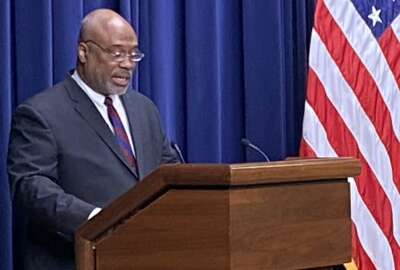
PALT in OFPP’s crosshairs
The Office of Federal Procurement Policy is putting a new emphasis on helping agencies reduce their Procurement Administrative Lead Time -- or “PALT.”
Best listening experience is on Chrome, Firefox or Safari. Subscribe to Federal Drive’s daily audio interviews on Apple Podcasts or PodcastOne.
The Office of Federal Procurement Policy is putting a new emphasis on helping agencies reduce their Procurement Administrative Lead Time. “PALT” is the time it takes between when an agency issues a contract solicitation and when it actually makes a contract award. And there’s good reason to focus on PALT: According to a new analysis by Bloomberg Government, the average lead time increased 72% over the last five years. BGOV’s Paul Murphy led the data analysis project, and he joined Federal Drive with Tom Temin and Federal News Network’s Jared Serbu to talk more about the rise of PALT.
Interview transcript:
Jared Serbu: Thanks for joining us, Paul. And let’s start by just talking about some of the baseline findings that you came away with after looking at this five years worth of procurement data. Beyond the headline number of the 72% increase in average PALT (Procurement Action Lead Time), what did you find when you looked a little bit below the numbers?
Paul Murphy: Well, we’re finding some interesting trends as you break the data down in a little bit more detail. We’re noticing a wide variation in trends from agency to agency. For example, we saw very low PALT for agencies like DHS; 47 days on average, but it ranged as high as 298 days for USAID. So it shows a very clear difference in the kind of the procurement environment, if you will, in different agencies. Some other things we saw too were a very clear stair step pattern in PALT as contracts grew in size — it was a very clear stair step increase in the lead time it took to handle large contracts. We saw, for instance, that the smaller ones — under a million — took just 54 days and they’re pretty routine. But as you got into the higher, all the way up to over $100 million is where we kind of capped it at, and $100 million and up contracts took 308 days from the original solicitation to the initial award of the contract.
Jared Serbu: Yeah, in a lot of ways that’s probably not surprising, right? Because the bigger the contract, the more complex it probably is, the longer it’s going to take an agency to evaluate all those bids it solicited.
Paul Murphy: Sure. And we are looking also at the causes of this, we’re trying to help our client fence in risk, help them anticipate how long it’s going to take from initial bid to award. And one of the things it helps to understand is that particularly in today’s environment with the efficiency initiatives we’re seeing, with category management — that’s pushing vendors to larger and larger contracts. There’s staffing lags at the agencies — the staffing is not keeping up with the growth in the contracts. And also, as these contracts become larger and more important to the companies, protests become a factor. And companies feel compelled to protest that they sense that a decision might not be to their advantage.
Jared Serbu: Yeah. And to that point, since there are larger contract vehicles now, a lot of things that would have been standalone contracts 10 years ago are probably coming off of IDIQs or BPA calls. Are you able to measure PALT off of those kinds of things and be able to tell if lead time is growing for something like a task order for an IDIQ?
Paul Murphy: Well, that’s that’s a really good question. You’ve correctly perceived that there’s different categories of PALT. And because of the nature of the way the data is reported in the solicitations file, we actually excluded all of the task orders. Because as you can imagine, a schedule contract, for instance, that got awarded five or 10 years ago, and it’s not an option period, there are these randomly reported task orders in the solicitations file that when you calculated them in it showed the PALT was some incredibly high number like six or seven years, and that’s really an outlier. And once we realized that there were these outliers and then we created algorithms to exclude them and work with a relatively clean set of data. We were looking at, as we described, just the CFO agencies — the 24 CFO agencies — they account for 99% of the dollars that the government spends. And we just looked at the prime awards, because that gave us the cleanest set of results.
Jared Serbu: Yeah, and kind of along those lines, OFPP issued some guidance in a new memo earlier this year that both created a common definition for PALT, including I think for IDIQs and BAAs, and also some some guidance for agencies to measure how they’re doing. Based on your read of that, is there reason to hope that we might be able to measure some of those things that you couldn’t measure this time around If you do this project again five years from now?
Paul Murphy: Oh, we’re going to try and keep doing it on a regular basis, because the data is incredibly important for our clients to be able to plan financially. But we tried to hew as closely as we could given the availability and the consistency of the data, we tried to hew as close as we could to the OFPP’s definition which came out in January, which followed a year of, I guess, internal discussions at OFPP following the 2018 inclusion of that clause in the John McCain NDAA bill for 2019. So it’s been a long standing concern by Congress and the agencies — they recognize it’s the problem. And so they’ve begun with this trying to create a consistent definition of PALT in order to be able themselves to manage it. And so the public, companies like ours, we have access to certain information in sam.gov and the solicitations database, and so we can work with a significant part. I think, ultimately, our analysis covered about 400,000 records. And a very tiny, I mean, well less than 1%, wound up including schedules, and BAAs really didn’t make statistically any difference in the results we came up with. But we left a very small number of them in because we thought that there might be some rare exceptions where these were consistently reported solicitations along with all the others that we measured.
Jared Serbu: Yeah, as we mentioned earlier that that stair stepping that you talked about — the correlation between contract size and length of PALT — there’s there’s some logic to that. But I gotta say, I was kind of surprised that even in the small category, for contracts worth less than a million dollars, the average was still something on the order of almost two months for PALT. I mean, that’s probably still nowhere near what the commercial equivalent would be in commercial industry for a contract of that size. When you break down by size, can you see progress in any particular category, is PALT actually decreasing anywhere that you can see in the data?
Paul Murphy: Well, relating back to your previous question, I think you would probably see a generally lower PALT with the task order solicitations. Again, we don’t have access to when the talk order solicitations came out. We do know when the awards came up, but because we determined that they didn’t necessarily correspond to the solicitation dates of the original contract, which is what we are intending to measure, I think you would actually see a lower PALT with the task order. You already have a pre selected group of contractors, you have expedited solicitation terms, request for quotes, and task order solicitations. They can have three, five, 10-day turnaround times for millions of dollars and awards. So I think that’s where you would see a lower PALT most likely, but until we get exposure of this level of data by the agencies, we’re left to looking at the prime awards. And that’s important, too, for agencies and companies to understand is that when companies foresee these contracts that they’re potentially bidding for, they’re looking for how much time am I going to have to carry employees? When am I going to have to start arranging financing? When are we going to have to start arranging hiring and startup costs if I’m bidding on a contract of a certain size? So the prime award, the fundamental vehicle awards that we are able to measure with this, has a lot of significance for companies. But once you get into the actual meat and potatoes of task order bidding and responses, I think you would actually see faster turnaround times.
Jared Serbu: And this is probably a difficult question to answer, Paul, but I’m gonna ask it anyway, just based on the data that you looked at, is there anything that you can see that might point toward causes for this increase in PALT?
Paul Murphy: Well, as I mentioned, I think the budget log jams — I think a lot of this can be laid at the feet of Congress. There’s a CRS report that came out a few years ago indicating that since 1977 there have been only three years that Congress has not had a continuing resolution. And so when you have continuing resolutions, it narrows the window that agencies have to bid, they could push that window into the next year, as far as two or three months. And given the PALT that we’re seeing, the various sizes of contracts can take two or 300 days, then they start working, the agencies start working backwards, and say, Well, if it’s going to take us two or 300 days, work back from September to June and even May, and that’s your window — from November to May. And so, PALT makes the agencies a lot more cautious. They don’t want to have to issue an RFP, and then wind up, for whatever reason, having delays or protest, pushing it past Sept. 30 when they lose their authorizations and they’re not sure if they’re going to have the money reauthorized until they get the new budget. So it affects behavior there. It causes consternation with the bidders because it increases their costs and uncertainty and risk. So the CRs, I think, are a critical aspect of it. But you also have this, we’ve shown our data in the last several months, we’ve been doing some research following particularly multiple award contracts and trends and best in class contracts. And there is a definite trend toward an increasing amount of money being spent on larger multiple award contracts. Overall, the data supports that larger and fewer contracts are going to larger and fewer companies. And there’s been a consolidation in the federal marketplace. So as these contracts grow in size, the PALT increases. As we discussed, it’s kind of a natural progression. And then there’s the bid protest, as we’ve discussed. Some of these bid protests can drag on for months — the Encore III protests dragged on for, took over 1,000 days to award. And I know this is very hard for agencies, as well as his companies, to respond to. And then there’s the sluggishness, the hiring sluggishness, the fact that (GS) 1101s and (GS) 1102s, the contract officers and the contract administrators, their employment has not been growing in the same rate as contracts have been increasing. So their portfolios are becoming larger and a little bit more complex. And something we want to look at going down the road is the average age of a contract officer comes into play here. Less experienced contract officers may have more difficulty handling complex procurements. And so we want to take a look at that and see if maybe there’s some staffing and training issues that need to be addressed as well on the government side.
Jared Serbu: Paul Murphy is a senior data analyst with Bloomberg Government.
Copyright © 2024 Federal News Network. All rights reserved. This website is not intended for users located within the European Economic Area.
Tom Temin is host of the Federal Drive and has been providing insight on federal technology and management issues for more than 30 years.
Related Stories




